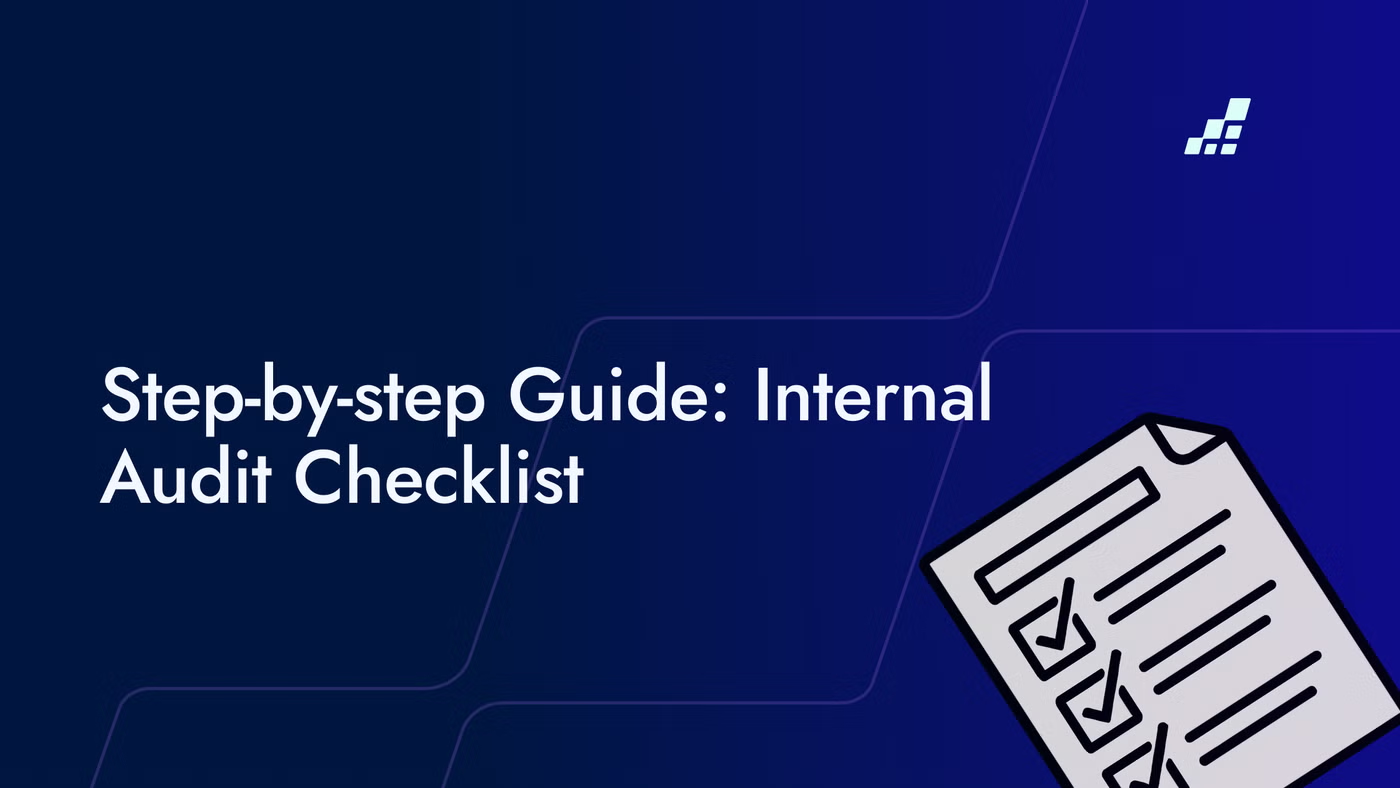- /
- Blog
Step-by-Step Guide: Internal Audit Checklist Template

An internal audit is vital for every organization, no matter how big or small, or what industry it's in. It's like a health check for your company, offering an unbiased look at how things are running. The goal? To spot any potential risks and find ways to make things better.
In this guide, we'll walk you through a detailed internal audit checklist. This way, you can make sure everything in your organization is working as it should, smoothly and effectively.
Why Internal Audit Matters
Before we get into the checklist, let's take a moment to understand what an internal audit really aims to do. It's not all about pointing out mistakes or areas where you're not following rules. Think of it as a forward-looking step that enhances how your organization operates and minimizes risks.
An internal audit digs into where things might not be as efficient as they could be, checks how well your control mechanisms are working, and makes sure you're in line with laws and regulations.
But that’s not all. These audits also bring valuable insights to your management team, aiding them in making well-informed choices. Plus, they're instrumental in building a culture where accountability and transparency are at the forefront.
Why a Checklist Beats Last-Minute Scramble
The checklist for Internal Audit
Preparing for the Internal Audit
Getting ready for an internal audit is all about preparation. You'll need a clear understanding of what you're auditing, the information required, and what you're aiming to achieve. Let's break down the steps to get you well-prepared for the audit.
Step 1: Define the Scope
Start by figuring out what exactly you're auditing. Is it a particular department, a process, or maybe the entire organization? Your audit's goals and the resources you have at hand will influence this decision.
Step 2: Gather Information
Next up, it's time to collect all the information relevant to the audit area. This might include policies, procedures, past audit reports, and other important documents. Going through these will help you get a solid grasp of the existing processes and controls.
Don't shy away from chatting with key people involved in the day-to-day operations, too. These conversations can uncover risks and improvement opportunities that aren't immediately obvious from paperwork.
Step 3: Set Clear Objectives
Having clear goals is vital for the audit's success. These objectives need to line up with the broader aims of your organization and the specific focus of the audit. Make sure they're SMART: specific, measurable, achievable, relevant, and time-bound.
Once you've established these objectives, share them with the audit team. This ensures everyone is moving in the same direction, aiming for the same outcomes.
Conducting the Internal Audit
After your prep work for the audit is done, it's go-time for the actual audit. Here's how you can navigate through this phase, step by step:
Step 4: Conduct Fieldwork
The fieldwork stage is where you dive deep into the organization's controls and processes. This might mean watching how things are done, going over documents, and talking to staff. Your goal is to check how well controls are working and spot any areas that could be better.
It's crucial to keep a clear and fair record of what you find. These notes are key - they back up your final conclusions and suggestions.
Step 5: Analyze Findings
With the fieldwork done, take a close look at what you've discovered. Search for any patterns or signs that point to bigger issues. Evaluate how significant any weak spots or problems might be.
Then, put together recommendations to tackle these issues. Your suggestions should be sensible, affordable, and in line with what the organization is trying to achieve.
Step 6: Report Findings
Now, it's time to share what you've found. Your audit report should lay out the findings clearly and include your advice for making improvements. Don't forget to add a plan of action that outlines the steps needed to fix the issues you've identified.
Share this report with management and go over the details with them. This conversation is crucial - it helps make sure they grasp the problems and are ready to do what's needed to sort them out.
Tips From the Field
- Hold a 30-minute monthly risk refresh with process owners. Ten minutes per function surfaces emerging issues faster than annual workshops.
- Break fieldwork into two-week sprints. Each sprint ends with a demo of completed workpapers for quick reviewer feedback.
- Automate the grunt work. Extracting invoice data, matching ledger lines, or creating cross-references can be done with Excel-native tools like DataSnipper, not extra portals. (That’s the approach taken by Air Products & Chemicals, where Lead Auditor EMEA uses automation to speed internal-control testing.)
Conclusion: Internal Auditing the Right Way
An internal audit is more than a check-up; it's a key to enhancing operations and mitigating risks. This checklist guides you through a thorough audit, aiming not just to find issues but to foster organizational growth. It's designed for auditors at any level, offering clear steps for a successful review.
FAQs
How often should risk assessments be updated?
Best practice is quarterly, but monthly “lite” refreshes flag new projects or incidents early without a full re-score.
What are the 5 C’s of internal audit findings?
Criteria, Condition, Cause, Consequence, Corrective Action—a simple structure that keeps reports clear and action-oriented.
How does automation fit into a checklist?
Automation removes copy-paste work: pulling populations, selecting samples, and cross-referencing evidence. The checklist still guides what to do; automation speeds up how.


.png?width=600&quality=70&format=auto&crop=16%3A9)
